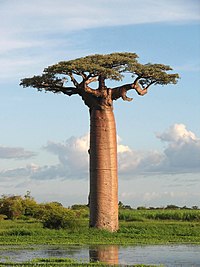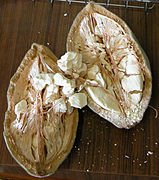| Adansonia | |
|---|---|

| |
| Adansonia digitata in Tanzania | |
| Scientific classification | |
| Kingdom: | Plantae |
| Clade: | Angiosperms |
| Clade: | Eudicots |
| Clade: | Rosids |
| Order: | Malvales |
| Family: | Malvaceae |
| Subfamily: | Bombacoideae |
| Genus: | Adansonia L.[1] |
| Species | |
|
See Species section | |
Of the nine species accepted as of April 2018, six are native to Madagascar, two are native to mainland Africa and the Arabian Peninsula, and one is native to Australia. One of the mainland African species also occurs on Madagascar, but it is not a native of that island. It was introduced in ancient times to south Asia and during the colonial era to the Caribbean. It is also present in the island nation of Cape Verde.[2] The ninth species was described in 2012, and is found in upland populations of southern and eastern Africa.[3] The African and Australian baobabs are almost identical despite having separated more than 100 million years ago, probably by oceanic dispersal.[4]
In the early 21st century, baobabs in Southern Africa began to die off rapidly from a cause yet to be determined. Scientists believe it is unlikely that disease or pests were able to kill many trees so rapidly, while some estimated that the die-off was a result of dehydration from global warming.[5][6]
Description
Baobabs reach heights of 5 to 30 m (16 to 98 ft) and have trunk diameters of 7 to 11 m (23 to 36 ft).[citation needed] The Glencoe baobab, a specimen of A. digitata in Limpopo Province, South Africa, was considered to be the largest living individual, with a maximum circumference of 47 m (154 ft)[7] and a diameter of about 15.9 m (52 ft). The tree has since split into two parts, so the widest individual trunk may now be that of the Sunland baobab, or Platland tree, also in South Africa. The diameter of this tree at ground level is 9.3 m (31 ft) and its circumference at breast height is 34 m (112 ft).[8]
Adansonia trees produce faint growth rings, probably annually, but they are not reliable for aging specimens, because they are difficult to count and may fade away as the wood ages. Radiocarbon dating has provided data on a few individuals. A specimen of A. digitata known as Grootboom was dated and found to be at least 1275 years old, making it one of the oldest known angiosperm trees.[8][9] The Panke baobab in Zimbabwe was some 2,500 years old when it died in 2011, and two other trees — Dorslandboom in Namibia and Glencoe in South Africa — were estimated to be approximately 2,000 years old.[5] Greenhouse gases, climate change, and global warming appear to be factors reducing baobab longevity.[5]
Species
Adansonia grandidieri, Madagascar
- Adansonia digitata L. – African baobab, dead-rat-tree, monkey-bread-tree (western, northeastern, central & southern Africa, in Oman and Yemen in the Arabian Peninsula, Asia and in Penang, Malaysia[11])
- Adansonia grandidieri Baill. – Grandidier's baobab, giant baobab (Madagascar)
- Adansonia gregorii F.Muell. (syn. A. gibbosa) – boab, Australian baobab, bottletree, cream-of-tartar-tree, gouty-stem (northwestern Australia)
- Adansonia kilima Pettigrew, et al. – montane African baobab (eastern & southern Africa)[3]
- Adansonia madagascariensis Baill. – Madagascar baobab (Madagascar)
- Adansonia perrieri Capuron – Perrier's baobab (northern Madagascar)
- Adansonia rubrostipa Jum. & H.Perrier (syn. A. fony) – fony baobab (Madagascar)
- Adansonia suarezensis H.Perrier – Suarez baobab (Madagascar)
- Adansonia za Baill. – za baobab (Madagascar)
Habitat
The Malagasy species are important components of the Madagascar dry deciduous forests. Within that biome, Adansonia madagascariensis and A. rubrostipa occur specifically in the Anjajavy Forest, sometimes growing out of the tsingy limestone itself. A. digitata has been called "a defining icon of African bushland".[9]
Ecology
Baobabs store water in the trunk (up to 120,000 litres or 32,000 US gallons) to endure harsh drought conditions.[12] All occur in seasonally arid areas, and are deciduous, shedding their leaves during the dry season. Across Africa, the oldest and largest baobabs began to die in the early 21st century, likely from a combination of drought and rising temperatures.[5] The trees appear to become parched, then become dehydrated and unable to support their massive trunks.[6]
Baobabs are important as nest sites for birds, in particular the mottled spinetail[13] and four species of weaver.[14]
Food uses
The cut fruit from Mozambique
Baobab powder
In the European Union (EU), prior to commercial approval, baobab fruit powder was not available for use as a food ingredient, as legislation from 1997 dictated that foods not commonly consumed in the EU would have to be formally approved first. In 2008, baobab dried fruit pulp was authorized in the EU as a safe food ingredient,[20] and later in the year was granted GRAS (generally recognized as safe) status in the United States.[21]
Regionally
In Tanzania, the dry pulp of A. digitata is added to sugarcane to aid fermentation in beermaking.[22] In Angola, the dry fruit is usually boiled and the broth is used for juices or as the base for a type of ice cream known as gelado de múcua. In Zimbabwe, the fruit is used in traditional food preparations which include "eating the fruit fresh or crushed crumbly pulp to stir into porridge and drinks".[citation needed] Malawi women have set up commercial ventures harvesting the baobab to earn their children's school fees.
Fresh fruit, seeds, leaves
The fruit pulp and seeds of A. grandidieri[23] and A. za are eaten fresh.[24] The fresh fruit is said to taste like sorbet.[25] The seeds of some species are a source of vegetable oil,[23][24] and their leaves may be eaten as a leaf vegetable.[9]
Other uses
Some baobab species are sources of fiber, dye, and fuel. Indigenous Australians used the native species A. gregorii for several products, making string from the root fibers and decorative crafts from the fruits.[26]
Gallery
Further reading
| Wikimedia Commons has media related to Adansonia. |
| Wikispecies has information related to Adansonia |
| Wikisource has the text of the 1911 Encyclopædia Britannica article Baobab. |
- Baum, D. A., et al. (1998). Biogeography and floral evolution of baobabs (Adansonia, Bombacaceae) as inferred from multiple data sets. Systematic Biology 47(2), 181–207.
- Braun, K. (1900) Beiträge zur Anatomie der Adansonia digitata L. F. Reinhardt, Universitäts-Buchdruckerei, Basel, OCLC 15926986
- Lowe, P. The Boab Tree. Port Melbourne, Australia: Lothian. ISBN 0-85091-912-6
- Pakenham, T. The Remarkable Baobab. New York: Norton. 2004. ISBN 0-393-05989-8
- Watson, R. The African Baobab. Cape Town, London: Struik. 2007. ISBN 978-1-77007-430-9





















Δεν υπάρχουν σχόλια:
Δημοσίευση σχολίου